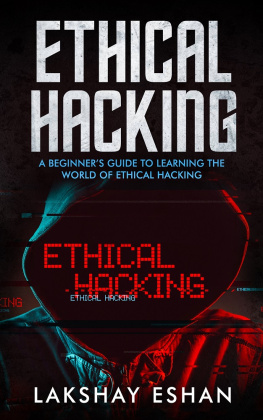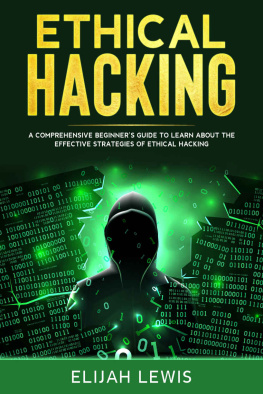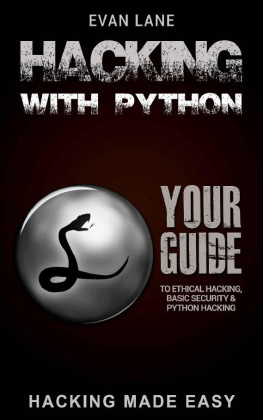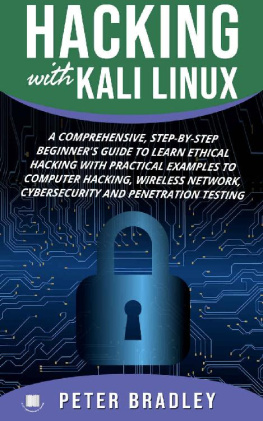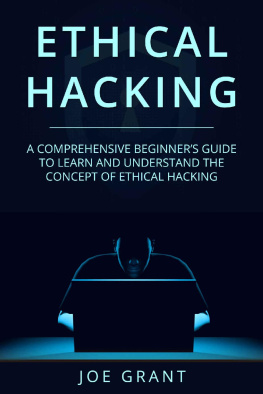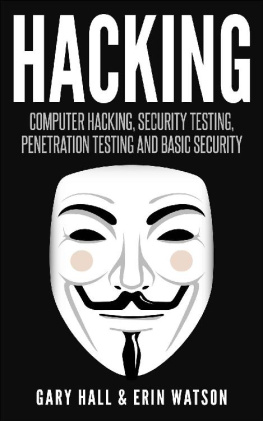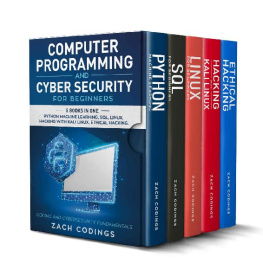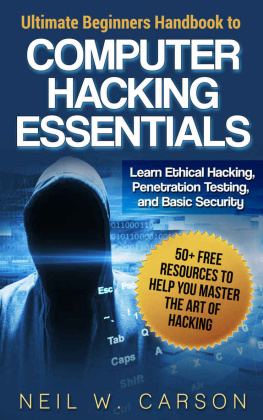McKINNON - THE FUNDAMENTALS OF COMPUTER SECURITY FOR BEGINNERS: A simple and comprehensive guide to start working in cybersecurity. Ethical Hacking to learn and protect your family and business
Here you can read online McKINNON - THE FUNDAMENTALS OF COMPUTER SECURITY FOR BEGINNERS: A simple and comprehensive guide to start working in cybersecurity. Ethical Hacking to learn and protect your family and business full text of the book (entire story) in english for free. Download pdf and epub, get meaning, cover and reviews about this ebook. year: 2020, publisher: UNKNOWN, genre: Romance novel. Description of the work, (preface) as well as reviews are available. Best literature library LitArk.com created for fans of good reading and offers a wide selection of genres:
Romance novel
Science fiction
Adventure
Detective
Science
History
Home and family
Prose
Art
Politics
Computer
Non-fiction
Religion
Business
Children
Humor
Choose a favorite category and find really read worthwhile books. Enjoy immersion in the world of imagination, feel the emotions of the characters or learn something new for yourself, make an fascinating discovery.

- Book:THE FUNDAMENTALS OF COMPUTER SECURITY FOR BEGINNERS: A simple and comprehensive guide to start working in cybersecurity. Ethical Hacking to learn and protect your family and business
- Author:
- Publisher:UNKNOWN
- Genre:
- Year:2020
- Rating:4 / 5
- Favourites:Add to favourites
- Your mark:
- 80
- 1
- 2
- 3
- 4
- 5
THE FUNDAMENTALS OF COMPUTER SECURITY FOR BEGINNERS: A simple and comprehensive guide to start working in cybersecurity. Ethical Hacking to learn and protect your family and business: summary, description and annotation
We offer to read an annotation, description, summary or preface (depends on what the author of the book "THE FUNDAMENTALS OF COMPUTER SECURITY FOR BEGINNERS: A simple and comprehensive guide to start working in cybersecurity. Ethical Hacking to learn and protect your family and business" wrote himself). If you haven't found the necessary information about the book — write in the comments, we will try to find it.
McKINNON: author's other books
Who wrote THE FUNDAMENTALS OF COMPUTER SECURITY FOR BEGINNERS: A simple and comprehensive guide to start working in cybersecurity. Ethical Hacking to learn and protect your family and business? Find out the surname, the name of the author of the book and a list of all author's works by series.
THE FUNDAMENTALS OF COMPUTER SECURITY FOR BEGINNERS: A simple and comprehensive guide to start working in cybersecurity. Ethical Hacking to learn and protect your family and business — read online for free the complete book (whole text) full work
Below is the text of the book, divided by pages. System saving the place of the last page read, allows you to conveniently read the book "THE FUNDAMENTALS OF COMPUTER SECURITY FOR BEGINNERS: A simple and comprehensive guide to start working in cybersecurity. Ethical Hacking to learn and protect your family and business" online for free, without having to search again every time where you left off. Put a bookmark, and you can go to the page where you finished reading at any time.
Font size:
Interval:
Bookmark:

GUY McKINNON
All rights reserved.
DEDICATION
To Jason McGregor, my teacher, mentor, and friend...
CONTENTS
HARDENING OF MOBILE DEVICES .................................................................................. 69
ENCRYPTION ................................................................................................................... 69
STEGANOGRAPHY ........................................................................................................... 74
PKI.................................................................................................................................... 74
LIFE CYCLE OF CERTIFICATES .......................................................................................... 76
DIGITAL SIGN................................................................................................................... 77
SENDER AND RECIPIENT ROLES...................................................................................... 78
OTHER APPLICATIONS .................................................................................................... 78
HARDWARE ENCRYPTION ................................................................................................... 79
VPNS ................................................................................................................................ 80
PHYSICAL SECURITY ........................................................................................................ 82
PRACTICAL EXAMPLES OF PENTESTING AND VULNERABILITY ANALYSIS ....................... 84
INSTALLATION OF OPERATING SYSTEMS .......................................................................... 85
METASPLOITABLE ................................................................................................................ 85
PRELIMINARY STAGE .......................................................................................................... 86
ARMITAGE ........................................................................................................................... 92
OPENVAS ........................................................................................................................... 101
CONCLUSIONS ................................................................................................................... 117
ANOMALIES .....................................................................................................................47
EURISTICA........................................................................................................................48
SDN ..................................................................................................................................48
FALSE POSITIVES AND FALSE NEGATIVES ......................................................................48
SEM AND SIEM ................................................................................................................49
DLP...................................................................................................................................50
LOG MONITORING ..........................................................................................................51
NETWORK LOGGING: SYSLOG ........................................................................................52
ANALYSIS TECHNIQUES...................................................................................................52
VULNERABILITY SCANNER ..............................................................................................53
PENETRATION TEST.........................................................................................................54
ACCESS CONTROL............................................................................................................55
CERTIFICATE ....................................................................................................................56
AUTHENTICATION ...........................................................................................................56
AUTHORIZATION .............................................................................................................58
ACCOUNT MANAGEMENT ..............................................................................................59
SUBNETTING ...................................................................................................................60
THE NAT...........................................................................................................................62
WIRELESS NETWORK VULNERABILITY............................................................................63
WIRELESS NETWORK ENCRYPTION ................................................................................63
WI-FI HARDENING...........................................................................................................65
PATCH MANAGEMENT ...................................................................................................65
HOST HARDENING ..........................................................................................................66
HARDWARE SECURITY ....................................................................................................66
VIRTUALIZATION .................................................................................................................67
CLOUD COMPUTING .......................................................................................................67
DATA PROTECTION .........................................................................................................68
v
INTRODUCTION TO INFORMATION SECURITY
3) Policies
Policies are nothing but guidelines to follow. We distinguish different types of policies that we can subdivide in this way:
A) Administrative Policies
Rules to be followed by those who run the business.
B) Disaster Recovery Plans
Choice of dangerous events.
C) Data policy
Who has access to what.
D) Security policy
Font size:
Interval:
Bookmark:
Similar books «THE FUNDAMENTALS OF COMPUTER SECURITY FOR BEGINNERS: A simple and comprehensive guide to start working in cybersecurity. Ethical Hacking to learn and protect your family and business»
Look at similar books to THE FUNDAMENTALS OF COMPUTER SECURITY FOR BEGINNERS: A simple and comprehensive guide to start working in cybersecurity. Ethical Hacking to learn and protect your family and business. We have selected literature similar in name and meaning in the hope of providing readers with more options to find new, interesting, not yet read works.
Discussion, reviews of the book THE FUNDAMENTALS OF COMPUTER SECURITY FOR BEGINNERS: A simple and comprehensive guide to start working in cybersecurity. Ethical Hacking to learn and protect your family and business and just readers' own opinions. Leave your comments, write what you think about the work, its meaning or the main characters. Specify what exactly you liked and what you didn't like, and why you think so.





